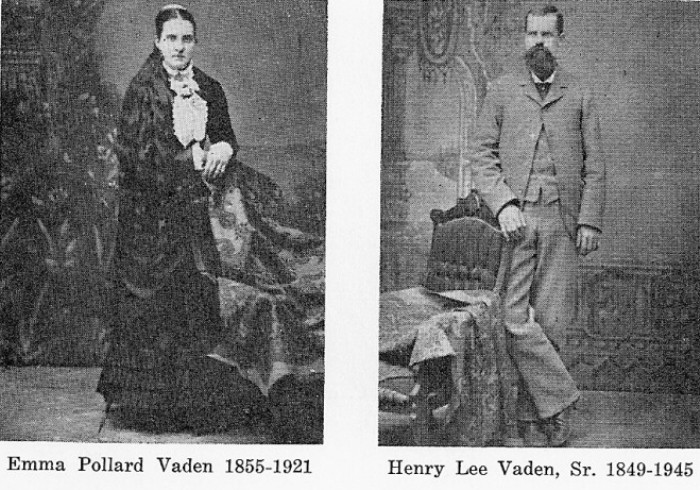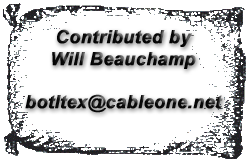|
HENRY
LEE VADEN SR.

From the Sherman
Democrat, December 1930
(approximately), written by my Aunt Mattie D.
Lucas, whose son, Howard Lucas, married Grace
Vaden.

"An
interesting visitor in Sherman during the
holidays is Henry L.
Vaden. Mr. Vaden was born in Grayson
County in 1849. His
father was James H. Vaden, who with his
family moved to Red River
County in 1843 when Texas was a
Republic. Mr. Vaden fought the
Indians in Red River County and again in
Grayson County where he moved
in 1845, before the county was
organized. He settled on the land
now known as the County Farm, which was
later sold to the County of
Grayson, reserving only the acre known as
the Vaden burying ground.
"Mr. Vaden was
on of the
commissioners appointed to lay off the
present site of Sherman,
receiving in payment for that service the
lot on the northeast corner
of the square now occupied by the Commercial
Bank building. He
afterwards traded this lot for an Indian
pony which he sold for $25.00.
"The 320 acres
where Sherman
was first located, 4 miles west of new
Sherman, was bought by Mr. Vaden
and sold by him during the War between the
States for a "lot of
Confederate money, some of which is still in
possession of the family,
now valued as an interesting relic of the
trying times of the 1860s.
"Henry Vaden
says, 'I do not
remember much of the conditions during the
war. I came to town
once a week with corn to have ground at the
old time ox-tread-wheel
mill, known as the Stewart Mill. It
was located on top of the
steep hill where the Andrews home now
stands, at the intersection of
Travis and College Streets, called Dugan's
Hill.
"' The first
school I attended
was in a little log house back of the home
field. This school was
taught by a man named Droke, a regular
down-east Yankee who came to
Grayson County about the same time we
did. Bill Walsh, now living
west of town, and Pum Wright of Purcell, my
home town, went to this
school too.
"'The first
preaching I ever
heard was by Parson McComb who lived in the
Farmington
neighborhood. He was a Hardshell
Baptist, a fine old man.
He preached for 2 solid hours, which was
pretty trying for a live
boy. Jack Jennings also preached
there. He was not of any
particular church but preached just good
religion - to suit himself.
"'The Masseys
owned the first
cotton gin I ever saw. Cotton was
raised only along the river,
wheat, oats and corn being raised further
inland. Father used to
run ox teams to Jefferson, taking grain down
thru Kentuckytown, then,
through "the devil's race-track", a road
fittingly named, through
Jernigan thicket; it was boggy, black and
sticky - no road at
all. Then through Black Jack Grove,
Sulphur Springs, and on to
Jefferson.
"'The wagons had
large bois
d'arc wheels and each one was drawn by 5
yoke of oxen. A lead
horse was taken along to hunt up the oxen,
and was hobbled, and the
others were tied by neckin' them, as it was
called. Each steer
was tied to his mate, the rope around the
neck; but this method was
some times unsatisfactory because the rope
would twist. A better
method was to use a stick, twisting it in
the rope around the necks of
the steers.
"'It didn't take
so much to
interest a fellow in those days. We
didn't have picture shows,
good roads and automobiles; but we did have
good horses, good hunting,
picnics and dancing. Many happy times
we had at Jack Jennings,
Burl Perry's (now the Tate home), Captain
Lee's, Captain Birge's, and
Sophia Porter's, whose home were always
centers of social
activities. 'Aunt' Sophia Porter (no
relation) had a beautiful
home, 100 negroes, and she loved a good
time. She was said to be
an old sweetheart of Sam Houston. She
frequently spent the night
with us when she came to attend the Grayson
County Fair. There
were, too, the Thompsons and Masseys where
every one enjoyed visiting.
"'We had great
times
hunting. Game was abundant and when we
wanted prairie chicken for
dinner, we went out and killed just what we
wanted for the time, and
not everything in sight as they do
now. We hunted turkey on
horseback; when near enough we would throw a
rope and knock them
down. I caught 4 turkeys this way just
a few years ago near
Madill. We caught quail by driving
them into a net. The
net, a bag, would be 10 feet long with hoops
to hold it open. On
each side from this extended wings 20 or 30
feet long. A covey of
quail was rounded up and slowly, not
crowding them too fast, driven
into the net. I have seen dozens
caught at one time in this way.
"'I attended
school after the
war in the old Odd Fellows Hall that stood
before the Texas and Pacific
Railroad built on Walnut Street just across
from where the T. & P.
freight depot now stands. It was a
large 2-story, frame
building. The school was taught by
Parson Petty, I
remember. Here were Fred and Joe
Cockrell. After this, in
1869 and 1870, I went to a boarding school
at Ladonia. It was the
first Baptist school, so far as I know, to
be established in
Texas. It was taught by Booker
Featherstone, a Baptist preacher
and a fine teacher. He had, several
years ago, a son living in
Henrietta, a big cow man. There were 4
other teachers in the
school. I boarded with Dr. H.
Harrison, Mollie Fitch, who
afterward married brother Jim, was there,
also, Alvis and Laura
Belcher, and a son of Parson McComb. A
Mr. Brown taught math and
Emmet Cox was another teacher."
"'The Odd
Fellows Hall was a 2
story frame building, one room above used by
the Odd Fellows and one
room below used as a school room during the
week and alternately by the
Methodists, Baptists, and Christians as a
meeting place on
Sunday. The seats were of split logs
and a shelf of split log
along the wall was used as a table upon
which to write.
"'The first
teacher here was
Jim Hurt who afterwards became a big lawyer
on the Supreme Court at
Dallas. Capt. Hurt entered the army in
1861. In 1865-66
this school was taught by a very smart
Irishman named Mingan who had
been educated in Dublin; he had also taught
with Capt. Hurt.
"'There attended
this school,
among others, Col. Eubank, a boy named
Graves, Jim and Betty Sacra, Wm.
and Missouri Bullock (Wm. Bullock was first
boy born in Sherman),
Mollie Fitch, Frank and Henry Vaden.
"'Quantrell's
men wintered in
Sherman 2 or maybe 3 winters - '62, '63,
'64. In '62 two of them
stayed at our house all winter. By the
next year people had begun
to be afraid of them. My father, this
winter of '63, kept 2 of
Capt. Nicholson's men. They were from
Fannin County and Honey
Grove; one, a cousin, was named Beasley.
"'Quantrell's
men were for one
or two winters at Flowing Well. By the
close of the war they had
become a band of desperadoes, killing and
thieving.
"'There was a
story that Sophia
Porter offered $40 for a strip of Jim Crow
Chiles' skin from his back
with which to make a razor strap, (J.C.
Chiles had Major Butts
killed.) Major Butts, in the winter of
'63, was killed supposedly
by Quantrell's men. He had sold cotton
and with the money was
returning homo. His body was found a
few days afterwards on the
branch near the North Travis road, about 3
miles north of town, half
starved and famished, so he looked about and
found Major Butts'
body. He was the husband of Sophia
Porter, living at Preston
Bend."
"'The year of
'62 was one of
bitter prejudice and hard feeling.
There were rumors of a plot
among the Union sympathizers to cause an
uprising among the negroes,
bring in the Indians from the Territory and
kill all the
Southerners. The plots were discovered
by Newt Chance who joined
the group. It was found they had a
list of names, headed by Col.
Wm. Young. Before anything could be
done, Col. Young was shot
from ambush.
"'A vigilance
committee was
organized, called the Wild Goose; a number
were arrested, tried before
a regular jury and judge, and hanged
immediately.
"'In
Gainesville, 48 were
hanged on one limb. Each day a few
were tried, were place on a
wagon driven immediately to the tree, a rope
put about each one's neck,
and the wagon driven out from under them.
"'This tree
stood across the
road just east of town. It was
completely destroyed by the
Federals who sent it north as souvenirs.
"'In Dodge City,
14 were hanged. In Howe, several,
among them a Mr. Gibbons and a Mr. Vivian.
"'Mr. Foster,
editor of the
Sherman paper, was taken out and shot, his
body left lying upon the
street. They tried to find Judge C.C.
Binkley but he escaped by
being away from home that night, his bed
being occupied by Bro. C.C.
McClain, Methodist minister.
"'A.M. Boyd was
taken from his
house and shot. His body was found the
next day in the creek-bed
about a mile from home. (Jim Young, Newt
Chance and Chas. Cox were the
leaders.)
"'Gen. Bourland
whose home was
on the River, north of Dexter, had charge of
the troops who protected
the frontier. (The Indians made a most
destructive raid, going down
into Denton County, and killing many people,
women and children.)
"'Col. George
Reeves organized the 11th Texas Cavalry;
they rendezvoused at Georgetown, north of
Pottsboro."
"'The first
preacher of the
Christian church I remember to preach after
the war, was Tom
Caskey. After the big debate between
Dichler and Swenney here,
the Campbellites built a church on the
corner of Houston and Montgomery
Streets, now used by John Locke as a tin
shop. Of all the old
time preachers, a blind preacher named
Rogers was the best, he was a
wonderful talker.
"'The first jail
of Grayson
County was on the block and right at the
back of where the City Hall
now stands on Jones street. It was a
curiosity in the way of
architecture, but served its purpose
well. It was built of big
logs, one room above the other. It was
called the
calaboose. A ladder went up on the
outside to an entrance in the
second story, up which the unlucky prisoner
was taken and then lowered
to the ground floor through a trap door in
the floor of the second
story. Small openings covered with
iron bars served to admit
light and air.'"
"Genealogy of the
Vaden and Related Families"
By Tennie
E.Vaden Winn 1969

Biography
Index
Susan Hawkins
©2025
If you find any
of Grayson
CountyTXGenWeb links inoperable,
please send me a
message.
|


